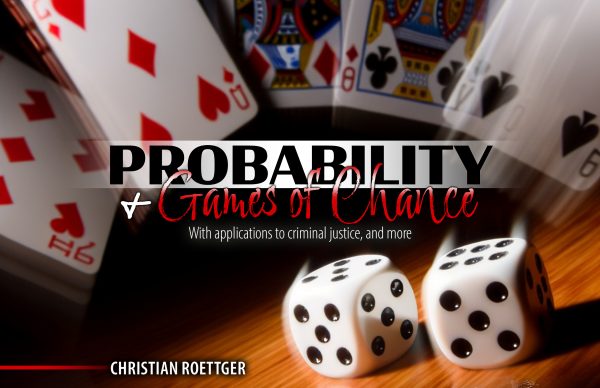Math 1040 – Introduction to Probability
Kirin Martin
jmartin4@iastate.edu
Catalog description
MATH 1040. Introduction to Probability (3-0) Cr. 3. F.S.SS. Prereq: Satisfactory performance on placement exam, 2 years of high school algebra, 1 year of high school geometry Permutations, combinations, probability, binomial and multinomial theorems, expected value, and applications. Either MATH 1040 or MATH 1500 may be counted toward graduation, but not both.
Textbook

Probability and Games of Chance: With Applications to Criminal Justice, and More ISBN: 9798385123254
Syllabus
- Basic language and results of probability: sample spaces, events, odds. (Sections 1, 2 and 3)
- Expected value. (Section 4)
- Roulette probabilities and expectation, a roulette strategy and its flaws. (Supplemental Notes; problems 57 and 58 in section 4)
- Tree diagrams, conditional probablitity, compound events. (Sections 5 – 7)
- Discussion and mathematical analysis of the dice game Craps. (Supplemental Notes)
- Introduction to basic combinatorics (Sections 8- 10)
- Using basic combinatorics to help analyze the probabilities associated with poker (Supplemental Notes)
- Using basic combinatorics to help analyze the probabilities associated with Lotteries. (Supplemental notes)
- Using basic combinatorics to help analyze the probabilities associated with Blackjack (Supplemental Notes)
- (Time permitting) Backgammon (Supplemental Notes)
Objectives
Basic rules of discrete probability
- Understand the concept of “sample space” and be able to construct sample spaces for simple experiments
- Understand the definition of “probability” in the case where all outcomes are equally likely
- Understand and be able to apply the basic rules for probability: the union, intersection and complement of an event
- Understand the concept of “conditional probability” and be able to compute the conditional probability of simple events
- Understand the significance of tree diagrams when computing conditional probability Understand the concept of independent events
- To have some exposure to real-life cases (e.g., court decisions) where the concept of independent events was misapplied
- To understand the concept of “expected value” and be able to compute the expected value in cases where the outcomes of an experiment, and their probabilities, are known
- To have some idea of how “expected value” is applied in certain real-life situations, including insurance policies and other forms of risk-taking
Basic principles of combinatorics
- To understand the meaning of combinations and permutations, and the difference between these ideas
- To know the definition of the binomial coefficients and to be able to compute simple examples of them
- To use the concept of combinations and permutations to solve simple counting problems
Applications to games and gambling
- To understand the basic rules and bets for poker (video, Texas Hold Em, and other variants) and to be able to compute the probabilities of the various hands
- To understand the basic rules of the game of Blackjack, to be able to compute simple probabilities associated with the game, and to understand the mathematics behind “card counting”
- To understand the basic rules of roulette, to be able to analyze the various bets using the concept of expected value, to understand why there is no such thing as a perfect “system” for winning this and other gambling games, to understand why European roulette (with no 00) is a better bet for the gambler than is American roulette
- To understand the rules of some of the various lottery games, including Powerball, and to be able to compute the probability of winning the jackpot, and to be able to appreciate why lottery tickets are such poor bets
- To understand the rules of Backgammon and to be able to use probability to determine the best moves in certain situations
- To apply conditional probability to analyze and understand the game of craps
- To use probability to analyze other games, including, for example, Farkle, Keno or Chuck-a-Luck
Free expression statement
Iowa State University supports and upholds the First Amendment protection of freedom of speech and the principle of academic freedom in order to foster a learning environment where open inquiry and the vigorous debate of a diversity of ideas are encouraged. Students will not be penalized for the content or viewpoints of their speech as long as student expression in a class context is germane to the subject matter of the class and conveyed in an appropriate manner.
Students with disabilities
Iowa State University is committed to assuring that all educational activities are free from discrimination and harassment based on disability status. Students requesting accommodations for a documented disability are required to work directly with staff in Student Accessibility Services (SAS) to establish eligibility and learn about related processes before accommodations will be identified. After eligibility is established, SAS staff will create and issue a Notification Letter for each course listing approved reasonable accommodations. This document will be made available to the student and instructor either electronically or in hard-copy every semester. Students and instructors are encouraged to review contents of the Notification Letters as early in the semester as possible to identify a specific, timely plan to deliver/receive the indicated accommodations. Reasonable accommodations are not retroactive in nature and are not intended to be an unfair advantage. Additional information or assistance is available online at www.sas.dso.iastate.edu, by contacting SAS staff by email at accessibility@iastate.edu, or by calling 515-294-7220. Student Accessibility Services is a unit in the Dean of Students Office located at 1076 Student Services Building. More information about disability resources in the Mathematics Department can be found at https://iastate.app.box.com/s/c17d3ljul83lujr2j1mdeqoqcdqiva1t.
